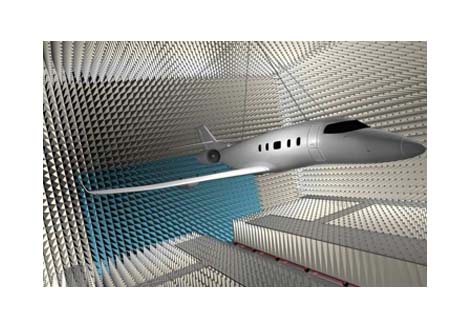Microwave anechoic chamber

The microwave anechoic chamber is mainly used to detect the radiation or scattering performance of the specimen to be tested, which is mainly divided into far-field anechoic chamber (including the compact field, which is mainly used for RCS detection), planar near-field anechoic chamber, cylindrical near-field anechoic chamber and spherical near-field anechoic chamber. Generally, large-scale radar antennas are used for near-field testing, and wide-wave speed antennas generally use spherical near-field and cylindrical near-field testing, and with the improvement of test requirements, the demand for multi-functional anechoic chambers (including near-field, far-field and EMC testing and integration) is gradually expanding.
Through the construction of the project, the electromagnetic environment and test conditions required for the electromagnetic compatibility test of the tested equipment are provided, which can effectively eliminate the interference of external electromagnetic waves and various reflected interference, so as to obtain reliable and standardized test data, and the main purpose is to carry out the compliance test of radiated emission and immunity.
Citation:
GB50826-2012 Technical Code for Electromagnetic Anechoic Chamber Engineering
GB/T12190-2006
GB/T50719-2011
GB50017—2003 Code for Design of Steel Structure
GB50009—2012 Code for Loading of Building Structures
GB50205—2001 Code for Acceptance of Construction Quality of Steel Structure Engineering
GB50034-2013 Code for Architectural Lighting Design
GB50052-2009 Code for Design of Power Supply and Distribution System
GB50019-2015 Code for Design of Heating, Ventilation and Air Conditioning in Industrial Buildings
GB50116-2013 Code for Design of Automatic Fire Alarm System
GB4717-2015
GB50016-2010 Code for Fire Protection Design of Buildings
GB50057-2010 Code for lightning protection design of buildings
GB/T2406-93
GB8624-2012
GJB6780-2009 "Microwave Anechoic Chamber Performance Test Method"
GJB5239-2004 Test Method for Absorption Performance of RF Absorbing Materials
Microwave anechoic chamber performance requirements
The performance of the anechoic chamber is tested by an independent third-party organization, and the main test indicators are shielding effectiveness, quiet zone performance, field average operation, and cross-polarization level.
Shielding efficiency index: meet the EN50147-1, GB/T 12190-2006 standard.
The performance of the quiet zone is determined by the DUT and the test requirements, which affects the measurement accuracy of the DUT.
Uniform field includes longitudinal field width uniformity, which is generally ≤± 2dB
Transverse field width uniformity, generally ≤± 0.25dB
Cross-polarization level, typically ≤ 25dB
Microwave anechoic chamber specifications
Planar near-field: It can test radar antennas with large volume and narrow wave velocity.
Cylindrical near-field: It can test large antennas with wide wave speeds.
Spherical near-field: 3D pattern test with wide wave velocity, such as ordinary base station antennas, 5G antennas, etc.
Compact field: It can be used for stealth characteristic test and far-field test.
Ordinary far-field: mainly for the test of not too large DUTs.
Simulation chamber: Simulation target characteristic measurement.
If you need more technical information, please contact sales, thank you!


